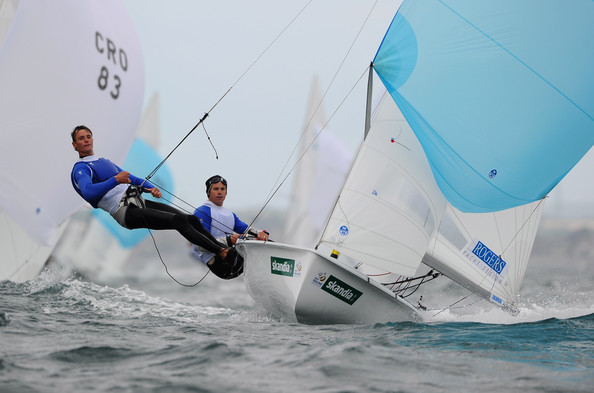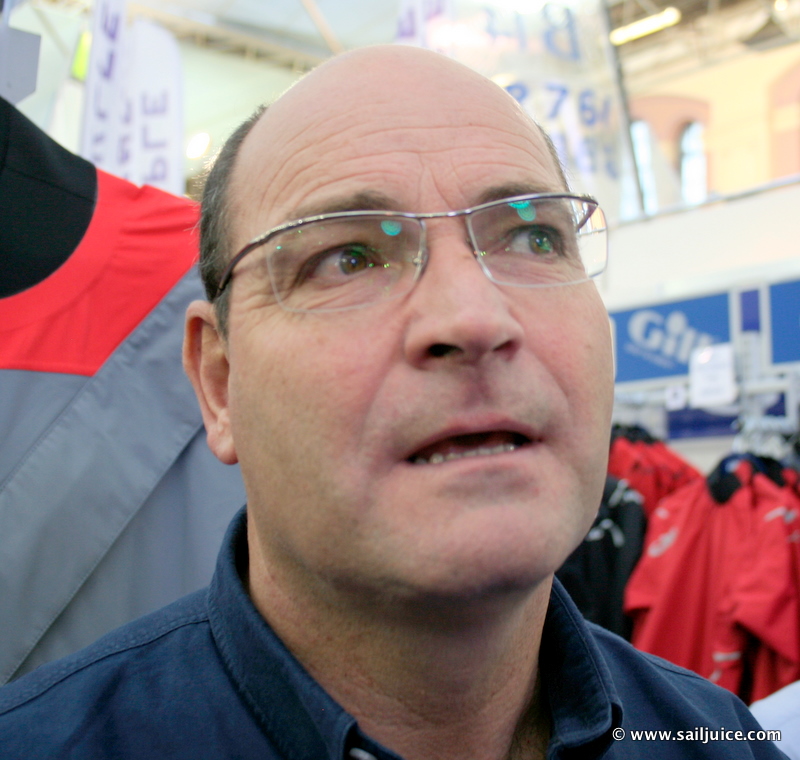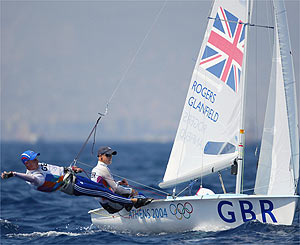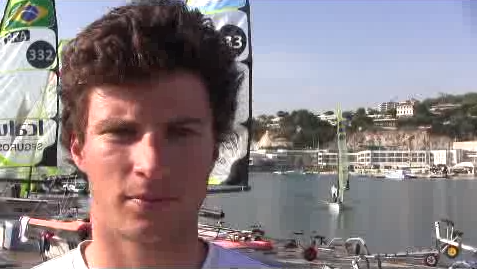Roll Tacks - April 2013
It’s a fascinating time in the Olympic cycle, especially with the sailors of both sexes getting to grips with new boats - and each other - in the compulsory boy/girl Nacra 17 catamaran.
Reading the reports from the women learning to master the 49er FX skiff and the mixed crews in the Nacra, the winter has been a catalogue of pitchpoles, capsizes and gear breakage. But they’ve been having great fun doing it. For full-time professionals used to operating at the top of the learning curve, honing the fine details to get that extra 0.5% of performance, getting in at the bottom of the curve offers a welcome change of pace.
Every day they go out sailing they make massive steps - not always forward, sometimes two steps in the right direction and one step back - but banking valuable experience on every outing. It’s great to see Pippa Wilson back in competition after a four-year hiatus. A late recruit to Sarah Ayton’s Yngling campaign, Pippa joined the two Sarahs (Webb being the other) to win gold at the 2008 Games. They were unstoppable in the Yngling, but who would have thought that none of those three would be part of the London 2012 team? Hopefully we may see one or both of the Sarahs back in competition, but at least Pippa - still only 27 - is back in the saddle.
Pippa is steering, with Iain Percy’s understudy in the Star, John Gimson, doing the work at the front. As I write, the Princess Sofia Trophy is underway in Palma and it’s interesting to note that of the four GBR crews entered, two have opted for girl helms and boy crews, and two have opted for the other way round. Which is best? Clearly too early to tell, although in a year’s time it may be that there is an accepted ‘wisdom’ in the Nacra class that you absolutely must sail in a certain configuration. One obvious comparison would be the Tornado campaigned by Carolijn Brouwer and Seb Godefroid whose career peaked with a 2nd place at a windy Tornado World Championship. Carolijn did the steering with former Finn medallist Seb doing the grunt work at the front. But the Tornado was a powerful and physically demanding boat whereas the Nacra is smaller and less loaded. So perhaps not such an obvious division of labour on the 17-footer.
Arguably the much more interesting question is how these male/female teams will gel at Olympic level. Examples of mixed teams in Olympic competition are far and few between, whereas for most of us weekend enthusiasts it’s probably the norm. Man and wife, boy and girlfriend travelling and competing together, what’s the big deal? We do it all the time. But how many Olympic sports can you think of where men and women compete side by side? Personally I was in favour of a compulsory mixed 470 class too, which was on the table before the 2016 Olympic classes were finalised last November. But when I dared suggest the idea in a boat park at a 470 European Championship a few years ago, I thought I was about to be burnt for heresy.
I can understand the objection. Doing a full-time Olympic campaign is a tough gig already, and adding gender brings another level to the challenge. It’s going to be interesting to see how it works out. This was Pippa’s observation as she went into her first regatta with John in Palma. “It is fantastic to be faced with such a difficult challenge, mentally, physically and with a new team mate. That is what the Olympics and life is all about – so John and I have accepted the challenge and every day is focussed on trying to become the best in the world in this new discipline.
“It is a very large mountain to climb, and the road will be full of highs and lows, but at the moment it feels like home to be out on the water following a new dream and trying to make the best of every day.”
Meanwhile in the 470 we have the mouthwatering prospect of our double Olympic silver medal winners, Nick Rogers and Joe Glanfield, competing in different boats. Nick has teamed up with Elliot Willis, who has won two 470 world titles with his former helmsman Nic Asher; Joe has stepped into the front of Luke Patience’s boat, the two silver medallists racing together in Palma for the first time. Joe is quite a bit smaller than Luke’s previous partner, Stu Bithell, but that’s OK because Rio is likely to be a good deal lighter than Weymouth.
It was for this reason that Stu jumped out of the front of the 470 into the back of a 49er, making the switch from crewing to helming. Coincidentally he’s crewed by another former crew of Luke Patience in the 470, Chris ‘Twiggy’ Grube who is now adapting himself to the bigger physical loads of 49er crewing. Nic Asher is another ex-470 sailor who is enjoying the move to the 49er. Although he won two 470 world titles, Nic has been dogged by chronic health issues in recent years, and attributed some of the problem to the incessant dieting he had to go through in order to remain competitive as a 470 helm. Now sailing with Fynn Sterritt, a newcomer to the Olympic trail, Nic is loving his new skiff career, even if he probably did more capsizing in a week of 49er training than he did in a lifetime of 470 racing.
So it has been a big game of musical chairs as Team GB restructures itself for Rio, and as ever we will some mighty big talent left on the sidelines when the team for 2016 is selected.
Reading the reports from the women learning to master the 49er FX skiff and the mixed crews in the Nacra, the winter has been a catalogue of pitchpoles, capsizes and gear breakage. But they’ve been having great fun doing it. For full-time professionals used to operating at the top of the learning curve, honing the fine details to get that extra 0.5% of performance, getting in at the bottom of the curve offers a welcome change of pace.
Every day they go out sailing they make massive steps - not always forward, sometimes two steps in the right direction and one step back - but banking valuable experience on every outing. It’s great to see Pippa Wilson back in competition after a four-year hiatus. A late recruit to Sarah Ayton’s Yngling campaign, Pippa joined the two Sarahs (Webb being the other) to win gold at the 2008 Games. They were unstoppable in the Yngling, but who would have thought that none of those three would be part of the London 2012 team? Hopefully we may see one or both of the Sarahs back in competition, but at least Pippa - still only 27 - is back in the saddle.
Pippa is steering, with Iain Percy’s understudy in the Star, John Gimson, doing the work at the front. As I write, the Princess Sofia Trophy is underway in Palma and it’s interesting to note that of the four GBR crews entered, two have opted for girl helms and boy crews, and two have opted for the other way round. Which is best? Clearly too early to tell, although in a year’s time it may be that there is an accepted ‘wisdom’ in the Nacra class that you absolutely must sail in a certain configuration. One obvious comparison would be the Tornado campaigned by Carolijn Brouwer and Seb Godefroid whose career peaked with a 2nd place at a windy Tornado World Championship. Carolijn did the steering with former Finn medallist Seb doing the grunt work at the front. But the Tornado was a powerful and physically demanding boat whereas the Nacra is smaller and less loaded. So perhaps not such an obvious division of labour on the 17-footer.
Arguably the much more interesting question is how these male/female teams will gel at Olympic level. Examples of mixed teams in Olympic competition are far and few between, whereas for most of us weekend enthusiasts it’s probably the norm. Man and wife, boy and girlfriend travelling and competing together, what’s the big deal? We do it all the time. But how many Olympic sports can you think of where men and women compete side by side? Personally I was in favour of a compulsory mixed 470 class too, which was on the table before the 2016 Olympic classes were finalised last November. But when I dared suggest the idea in a boat park at a 470 European Championship a few years ago, I thought I was about to be burnt for heresy.
I can understand the objection. Doing a full-time Olympic campaign is a tough gig already, and adding gender brings another level to the challenge. It’s going to be interesting to see how it works out. This was Pippa’s observation as she went into her first regatta with John in Palma. “It is fantastic to be faced with such a difficult challenge, mentally, physically and with a new team mate. That is what the Olympics and life is all about – so John and I have accepted the challenge and every day is focussed on trying to become the best in the world in this new discipline.
“It is a very large mountain to climb, and the road will be full of highs and lows, but at the moment it feels like home to be out on the water following a new dream and trying to make the best of every day.”
Meanwhile in the 470 we have the mouthwatering prospect of our double Olympic silver medal winners, Nick Rogers and Joe Glanfield, competing in different boats. Nick has teamed up with Elliot Willis, who has won two 470 world titles with his former helmsman Nic Asher; Joe has stepped into the front of Luke Patience’s boat, the two silver medallists racing together in Palma for the first time. Joe is quite a bit smaller than Luke’s previous partner, Stu Bithell, but that’s OK because Rio is likely to be a good deal lighter than Weymouth.
It was for this reason that Stu jumped out of the front of the 470 into the back of a 49er, making the switch from crewing to helming. Coincidentally he’s crewed by another former crew of Luke Patience in the 470, Chris ‘Twiggy’ Grube who is now adapting himself to the bigger physical loads of 49er crewing. Nic Asher is another ex-470 sailor who is enjoying the move to the 49er. Although he won two 470 world titles, Nic has been dogged by chronic health issues in recent years, and attributed some of the problem to the incessant dieting he had to go through in order to remain competitive as a 470 helm. Now sailing with Fynn Sterritt, a newcomer to the Olympic trail, Nic is loving his new skiff career, even if he probably did more capsizing in a week of 49er training than he did in a lifetime of 470 racing.
So it has been a big game of musical chairs as Team GB restructures itself for Rio, and as ever we will some mighty big talent left on the sidelines when the team for 2016 is selected.
Related Articles

Roll Tacks - April 2012
Much as I love my Musto Skiff, there’s no substitute for the buzz of being part of a team that is all pulling in the same direction. I don’t know about you, but for me, when you’re sailing in a team the highs are higher and the lows are lower. Sometimes when you’re working well together, it seems like the team can be greater than the sum of its parts. But if you’re at loggerheads, then things can fall apart very quickly.
Read More

Sailing Talk Podcast - A few surprises from Skandia Sail for Gold 2011

Read More

The Olympic scene is hotting up with just over a year to the London 2012 Games. Skandia Sail for Gold threw up a few surprises recently, with some old names coming back from the dead to displace the young upstarts. Justin and Andy look at how the form book is running, and who’s looking good for gold next year...

MP3: Being shouted at? Should you stay or should you go? ***
 Top coach and former Fireball World Champion crew Adam Bowers has been through his good and bad sailing partnerships. Most of us have endured being shouted at, and I doubt many of us get much pleasure out of it. So we asked Adam about how to make sure you're in the right team, and if you're going through a rough patch, when to work through your 'marriage problems', and when to walk away...
Top coach and former Fireball World Champion crew Adam Bowers has been through his good and bad sailing partnerships. Most of us have endured being shouted at, and I doubt many of us get much pleasure out of it. So we asked Adam about how to make sure you're in the right team, and if you're going through a rough patch, when to work through your 'marriage problems', and when to walk away...
Read More

GBR coach helps 470 girls to avoid his Athens 2004 mistake
Read More
 Eight years ago in Athens, Joe Glanfield had wrapped up an Olympic silver medal with a race to spare. He was sailing in the men’s 470 with helmsman Nick Rogers and if they played their cards right against the Americans in the final race, a gold medal might even come their way. But it didn’t work out that way.....
Eight years ago in Athens, Joe Glanfield had wrapped up an Olympic silver medal with a race to spare. He was sailing in the men’s 470 with helmsman Nick Rogers and if they played their cards right against the Americans in the final race, a gold medal might even come their way. But it didn’t work out that way.....

James Peters starting in a tough fleet
Read More
 James Peters, one of Britain's up and coming 49er stars, talks about starting in a tough fleet at the 49er World Championships in Marseille. With a left-favoured course, getting a start and holding your lane is a critical skill. James talks about his approach to creating a gap and being able to put the bow down for good speed off the line....
James Peters, one of Britain's up and coming 49er stars, talks about starting in a tough fleet at the 49er World Championships in Marseille. With a left-favoured course, getting a start and holding your lane is a critical skill. James talks about his approach to creating a gap and being able to put the bow down for good speed off the line....
